Going Back to Toys R Us
While U.S. stores all closed in 2017, the big box toy retailer is still alive and well just over the border.
Welcome to another edition of Willoughby Hills!
This newsletter explores topics like history, culture, work, urbanism, transportation, travel, agriculture, self-sufficiency, and more.
If you like what you’re reading, you can sign up for a free subscription to have this newsletter delivered to your inbox every Wednesday and Sunday and get my latest podcast episodes:
I am currently in Canada for the weekend for a family wedding. There’s a lot of things that I hope to see while I’m up here, but I’ve already checked one of the most important ones off of my list: a stop at Toys R Us.
I’ve written about my connections to Toys R Us before. My first official job as a teenager was as a cashier at the store in Mentor, Ohio. I ended up staying with the company for five years through high school and college, working in six stores across three states.
I’ve also written about how Toys R Us has been experimenting with “store within a store” concepts for decades. At times, they used their mainline big box locations as a location for other brands (Kids R Us, Imaginarium, FAO Schwarz). At others, they have tried to extend the Toys R Us brand into other retail including Giant, Albertson’s, Kroger, and eventually Macy’s, where Toys R Us currently houses a small boutique.
Toys R Us declared bankruptcy and liquidated its U.S. stores in 2017, but the U.S. bankruptcy court filing didn't affect international locations. The Canadian operations were spun off into a separate business and continue to operate, with about 80 stores spread across the country. Visiting these stores is both a nostalgic time trip and offer some clues as to what it takes to make a big box store successful in 2023.
My visit was to the store in Saint Catherines, Ontario, not far from the U.S. border. The exterior of the store was in pretty rough shape, with the plastic letters in the logo cracking and the paint peeling. Like many Canadian stores, this one has been retrofit with a Babies R Us, which is both incorporated into the overall store, but also has a separate entrance and branding.
Even when I worked at Toys R Us in the early 2000s, Babies R Us was considered the more profitable arm of the company. When Toys R Us declared bankruptcy, there was speculation that a buyer could have materialized to buy just the baby business and continue to operate it. That didn’t happen, although just last month, the first new Babies R Us store in the U.S. opened at the American Dream mall in New Jersey, where Toys R Us also operates its lone U.S. standalone store. There’s speculation that the demise of Buy Buy Baby, which was owned by Bed Bath and Beyond and closed as part of that chain’s recent liquidation, may present an opportunity to reignite the Babies R Us brand in a bigger way across the U.S.
In Canada, a fair amount of floor space is devoted to Babies R Us, and it’s largely separated from the rest of the store, aside from two passageways. There are strollers and car seats on display in a way that they are easy to demo and test. There’s also a section with baby clothes and baby accessories. I was fortunate when my kids were younger that we had both Babies R Us and Buy Buy Baby available to be able to touch and try each item, a definite advantage over online shopping.
Moving into the core of the store, things look remarkably like they did in 2017 at the U.S. stores. While the exterior was in tough shape, the inside was immaculate. The floors had a glossy shine to them, there was not a single light bulb burned out in the ceiling, and nearly every shelf was full with merchandise.
For some reason, I was expecting a store frozen in amber. Without the U.S. headquarters, I imagined the Canadian stores to be a time capsule from when the chain was larger. But in fact, everything was still current. There was overhead signage and even a photo opportunity for the new Barbie movie, for example.
Not far from the Barbie aisle, there was another interesting brand partnership. Claire’s was once a mall staple, selling accessories like jewelry and hair ties and offering ear piercing. At Toys R Us, there’s an entire Claire’s branded aisle (a store within a store!) featuring many of the same accessories that are found in the mall stores.
Claire’s seems to be on a similar brand extension journey to Toys R Us at the moment. With traditional mall traffic way down, Claire’s has been expanding into grocery stores and other retail. They currently have branded merchandise in Albertson’s, Kroger, CVS, and Wal-Mart. It seems that this co-branded mini-store in Canadian Toys R Us stores is another attempt to keep the brand top of mind.
The rest of the Toys R Us experience in Canada feels very familiar. There’s the wall of assembled bikes, each with a tag that shows the recommended size of the child who can ride it. Like the strollers in the Babies R Us section, it’s much easier to choose a bike by sitting on it and testing it out than by guessing at an online listing.
One interesting section that was not in U.S. stores (and I’m not sure how recently it was added to Canadian stores) is a large book section. In fact, it’s reminiscent of the kid’s department at Barnes and Noble. It has a lot of picture books and coloring books for younger readers, but it also has a section for older readers. There’s even a pair of comfortable chairs that encourage reading.
In a U.S. store, the section dedicated to books would have formerly been called Imaginarium, and it would have been home to learning toys like Lego, wooden train sets, and wooden puzzles. Granted Canada and the U.S. are different markets, but seeing this space converted to a small bookstore may make sense. I’ve written before about the unexpected revitalization of Barnes and Noble in the U.S.
Part of Barnes and Noble’s regrowth strategy has been to lean in to curation over quantity. Local stores have been given a lot of freedom to choose their inventory based on what store employees think will resonate. I’m not sure that Toys R Us is doing quite that level of curation, but there seemed to be some effort made to suggest books and show that this was not a dumping ground for all titles, but rather a home for good books worth sharing with kids.
It was a bit strange revisiting Toys R Us again after a six year absence. On the one hand, I was instantly transported back to shopping with my kids when they were younger and working at the store when I was a teen. But I also had the strange feeling that the store was not quite as “special” as I remembered it.
Most big box stores are just big warehouses packed with as much merchandise as possible. Toys R Us is taking some steps towards creating a nicer experience that feels a bit more curated, but at the end of the day, it’s still a big space lit by fluorescent tubes.
It doesn’t have the same level of character or care that a small, local toy shop would have, one where the owner knows his or her customers and can make personalized recommendations. The workers we encountered at this particular location were friendly, but I also felt like we could have had a perfectly fine shopping experience without ever talking with an employee. They didn’t make or break our visit, they were just there.
I’ve also been rethinking our collective relationship to consumption and “stuff,” especially after interviewing Sandra Goldmark on the podcast. A massive store like this needs a massive amount of stuff to look full. It needs to sell a lot of stuff to stay in business. How many variations on the Hot Wheels car or Barbie doll does one child really need?
I’m sure there are readers that were either too old or too young for Toys R Us that are wondering what all the fuss was about. For me, the store represents more than it actually is. It’s a reminder of shopping with my grandmother, who also died in 2017. It’s a reminder of working my first job. It’s a reminder of shopping with my kids as babies.
The logo with the backwards R and the image of Geoffrey the Giraffe are symbols and reminders of something else. While there are advantages to buying a bike or stroller in person, there’s hardly a case to be made for making the trip to Toys R Us for Monopoly, a Barbie doll, or a Lego set. These can be ordered online more conveniently (and likely for less money). They can be purchased at Target or Wal-Mart while also buying toilet paper and cleaning supplies.
As Toys R Us, Claire’s, and other brands seem to show, there’s sometimes more power in a brand name and logo than in a physical presence. I think this is especially true in the era of Amazon, where no name brands proliferate.
It was nice to be able to visit Toys R Us again here in Canada, although I can also understand why it’s no longer a going concern in the U.S. I have nostalgia for it, but I also am okay with what happened. At any rate, it’s nice to know that if I ever need a toy fix, there’s still a store with a backwards R ready to greet me just across the border.
Thanks for reading Willoughby Hills! Subscribe for free to receive new posts and support my work.
Related Reading
The Many Incarnations of Toys R Us
If you’ve missed past issues of this newsletter, they are available to read here.


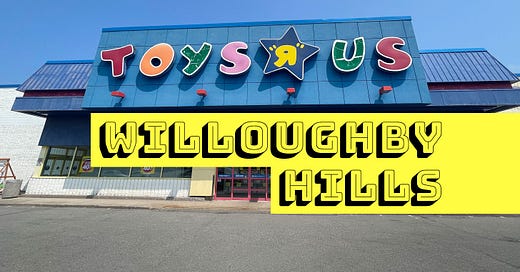


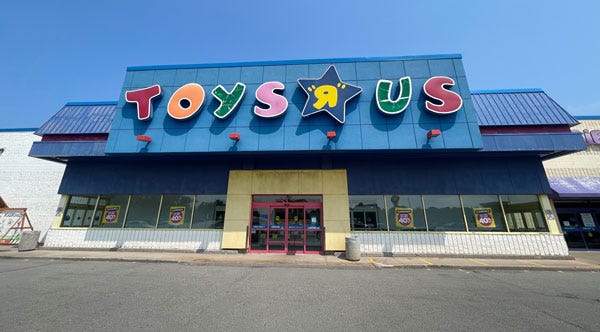
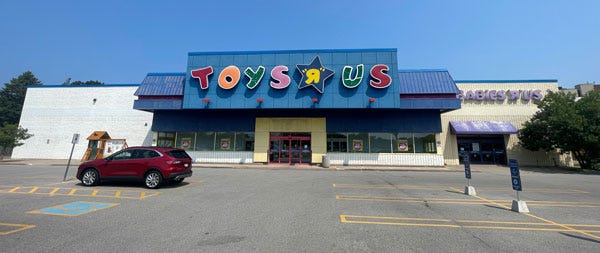
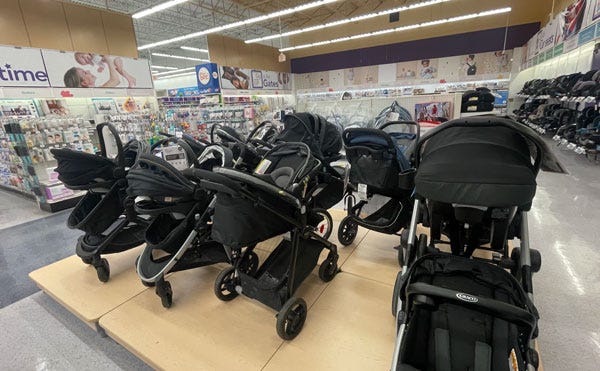
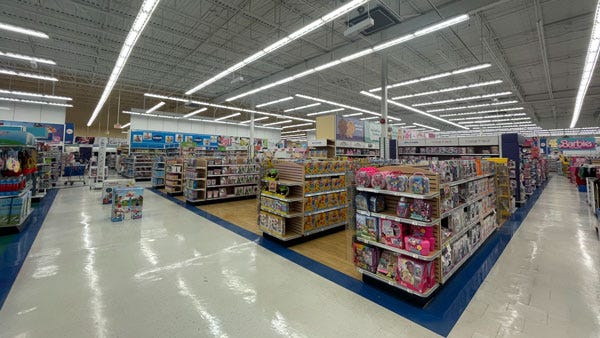
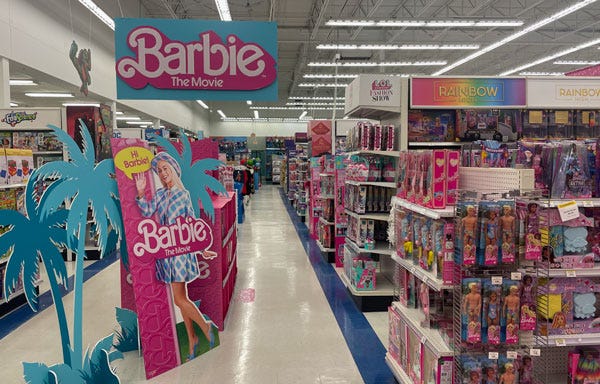
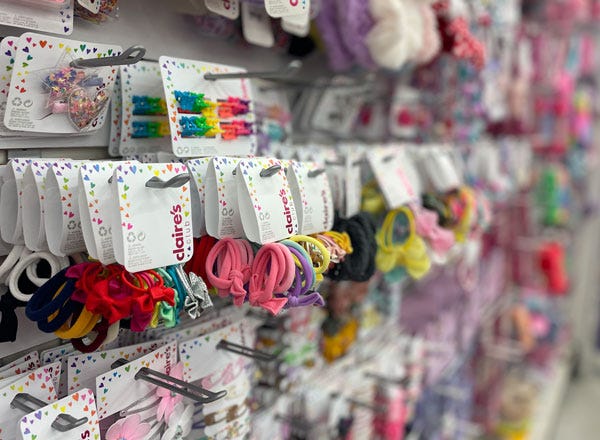


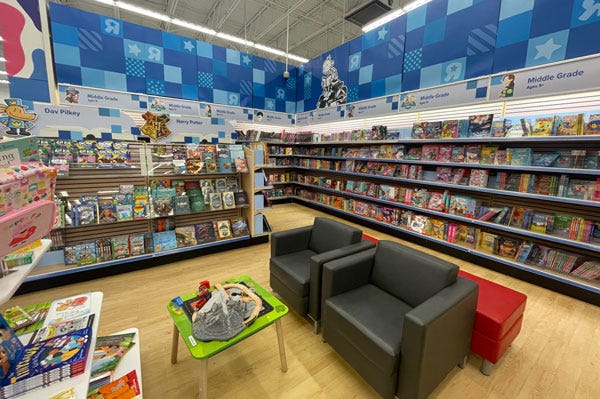
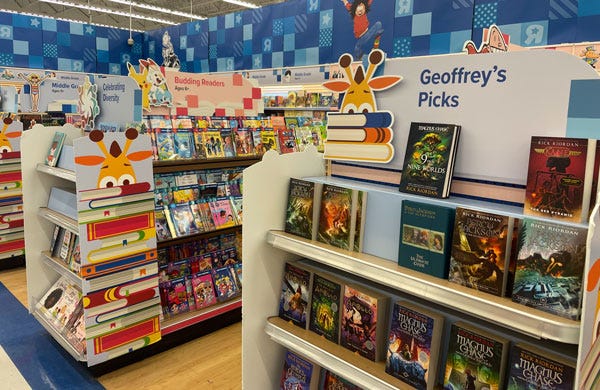
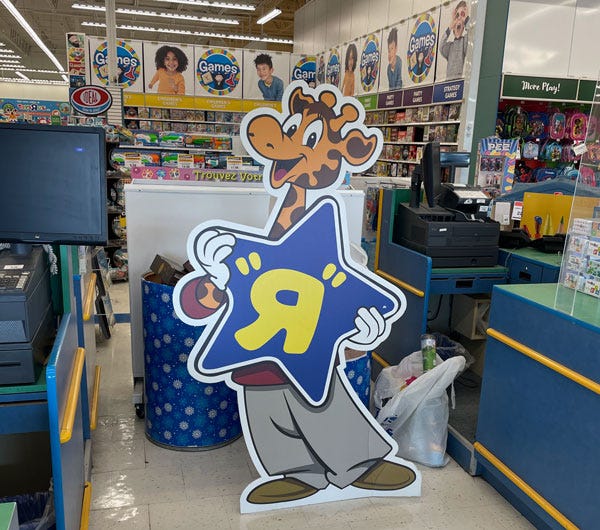

The Toys R Us I consider mine ( which I think is the second of two locations that were in Greensboro), had that large book section, with the books, in the 90s, while down the street from my beloved Borders and a mall with a Waldenbooks.
Also, I felt like the store was a winner when I was little, if the shelves were tall and full of toys almost to the ceiling. I hated the renovations that made the shelves shorter, especially the elimination of the board game wall and the discount section at the beginning.
But as you said, these were warehouses, full of stuff and they had those of us who were in the “Toys R Us kids” demographic in a trance of never wanting to grow up, I guess so we could forever spend money there tugging on our parents heels.
You had me at Toys "R" Us! Nice report!